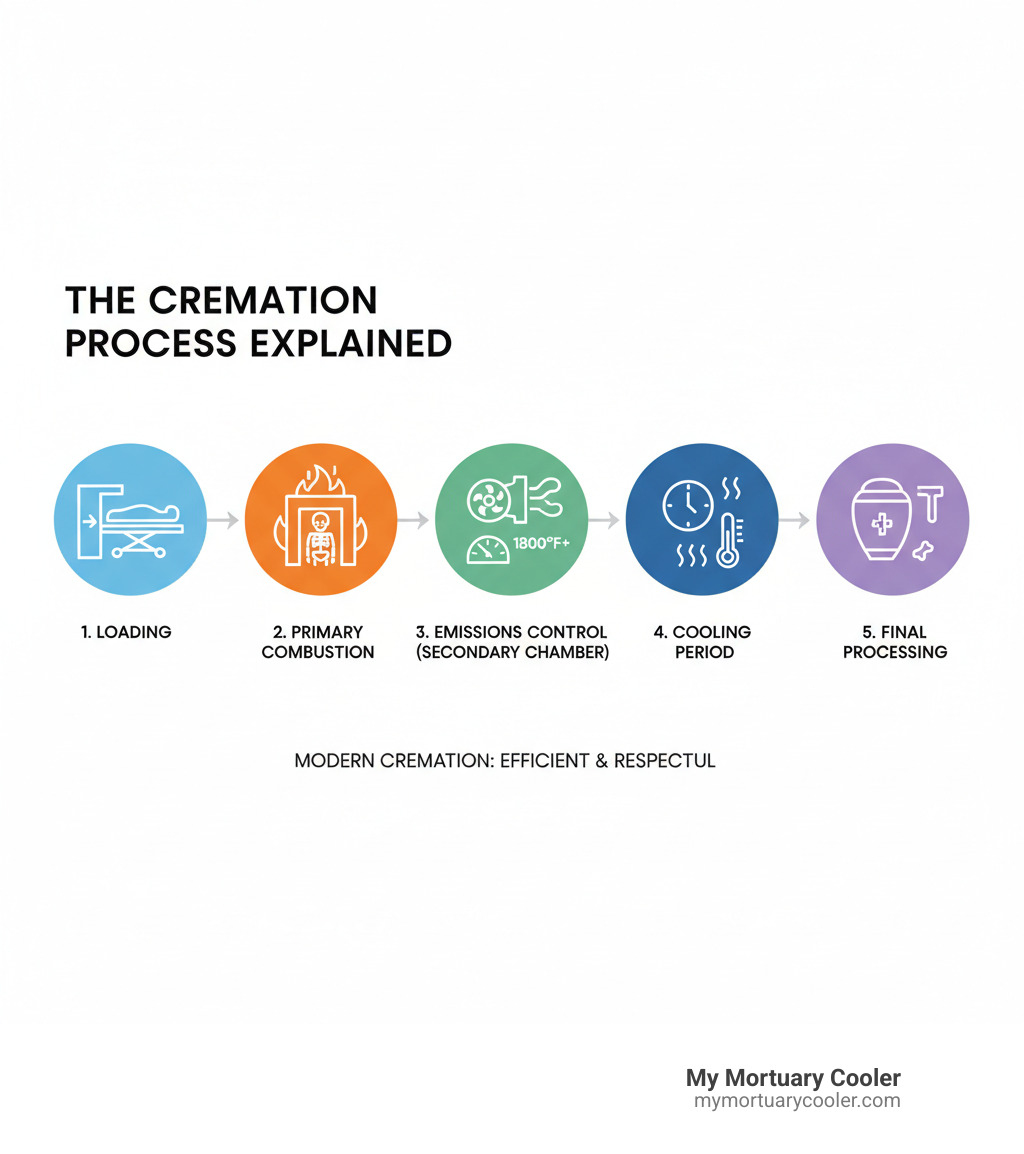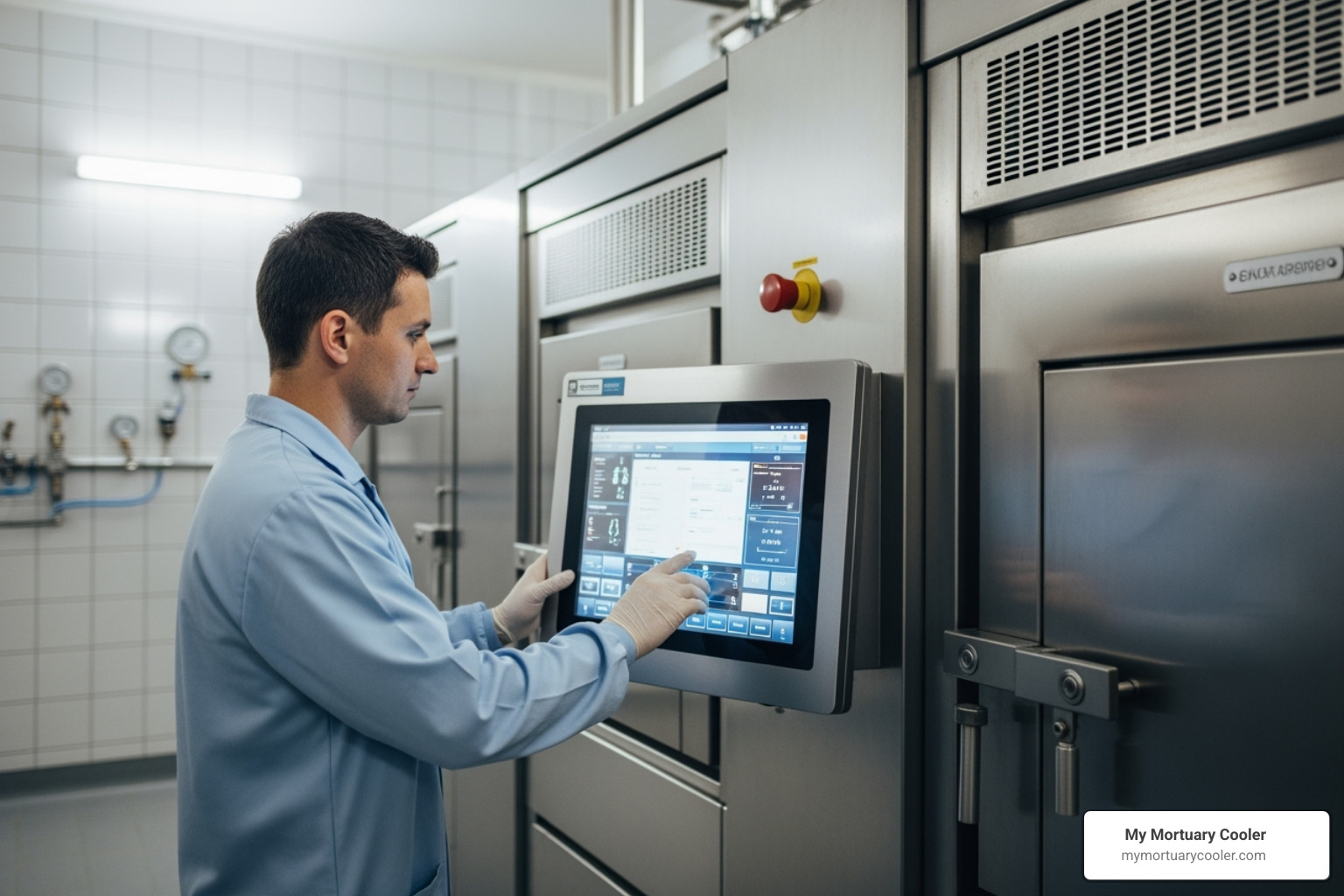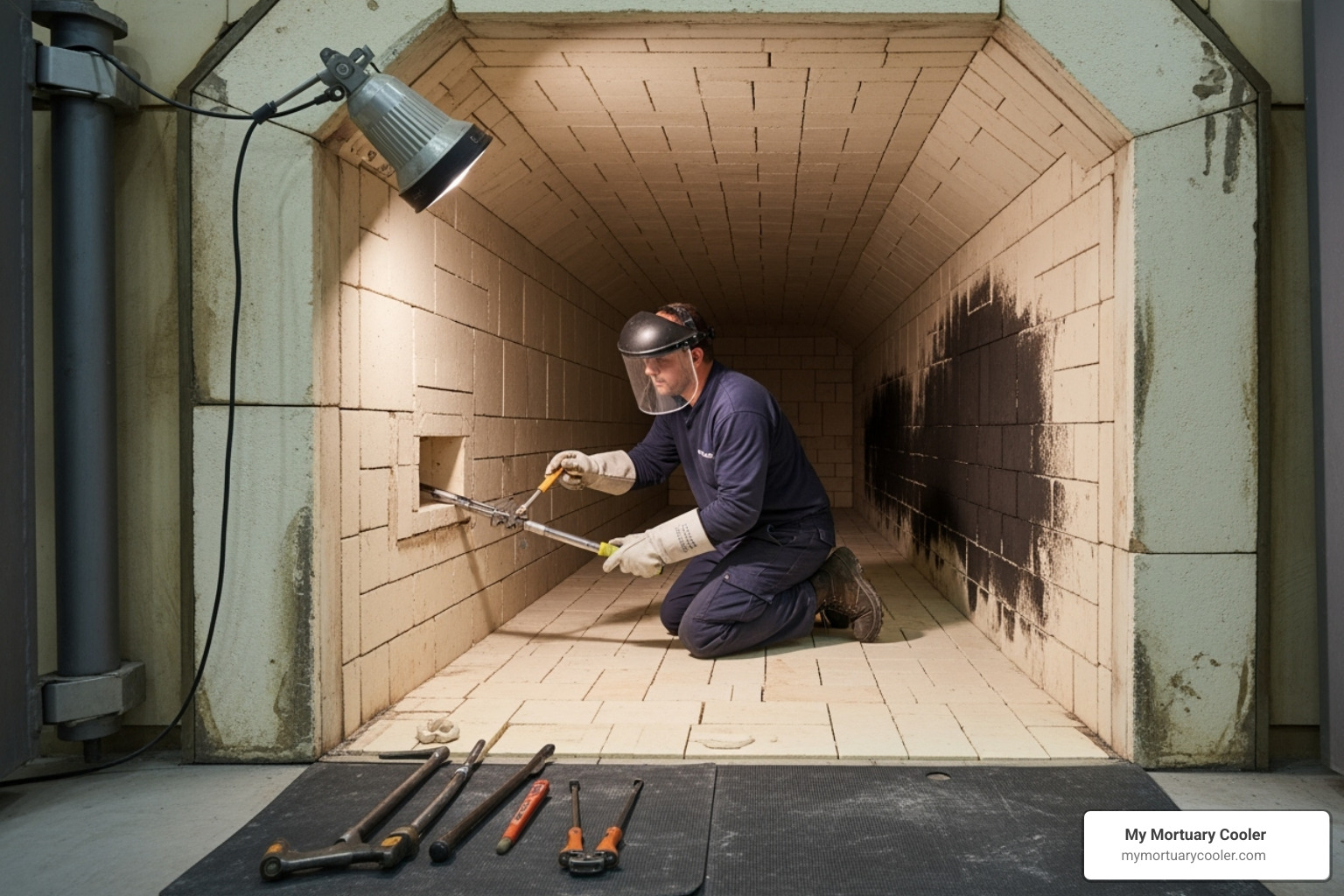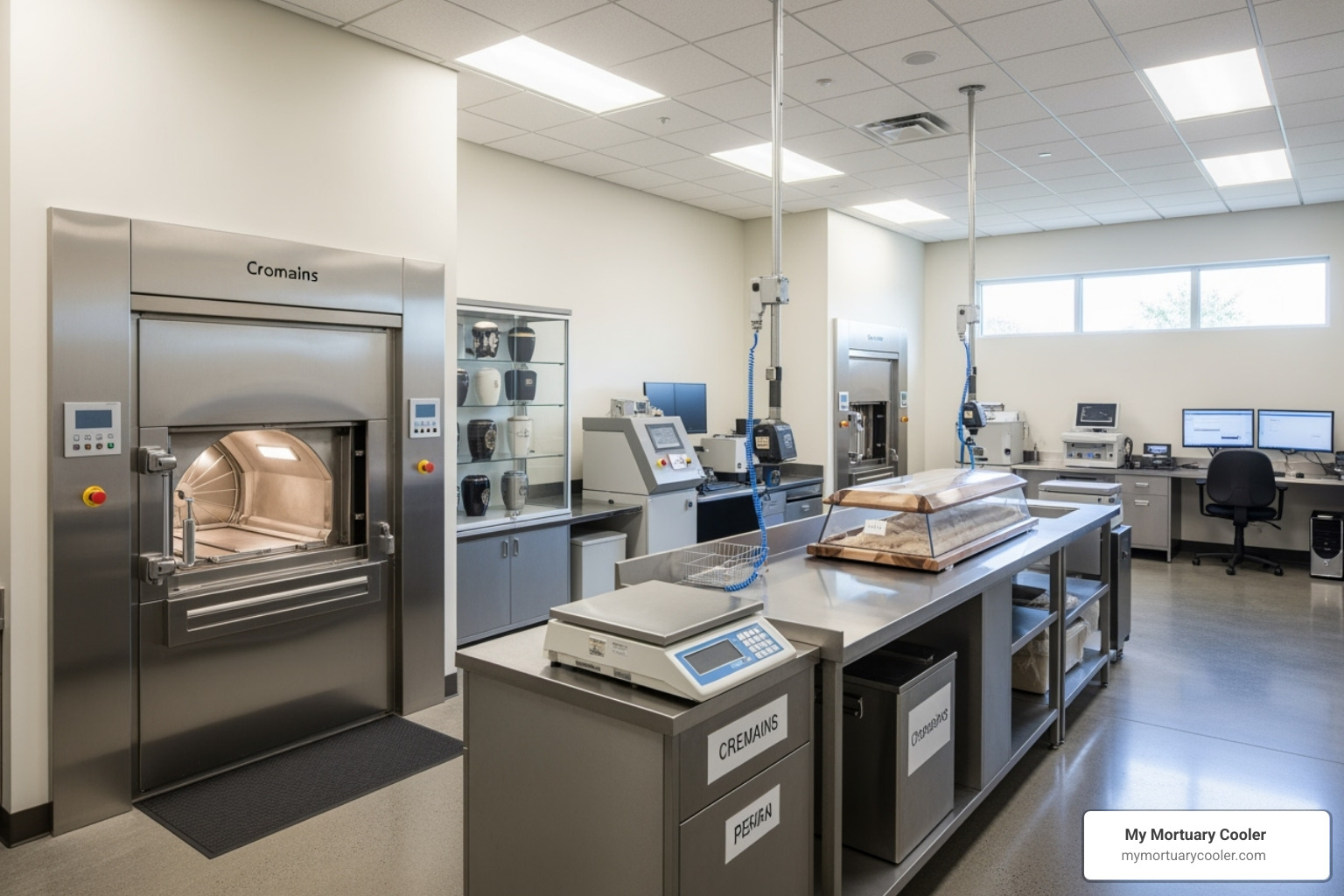Understanding the Growing Market for Cremation Furnaces
Searches for cremation furnace for sale have surged as the death care industry experiences unprecedented growth. The global cremation furnace market, valued at $1.1 billion in 2022, is projected to reach $1.7 billion by 2030 with a 5.8% annual growth rate.
Quick Answer for Buyers:
- Price Range: $35,000+ for new units, varies by capacity and features
- Types Available: Human cremation (60% of market), pet/animal units (fastest growing at 6.5% CAGR)
- Key Features: Automated controls, EPA compliance, 45-150 minute cremation times
- Capacity Options: 750-1,200+ lbs for human units, smaller ranges for pet cremation
- Fuel Sources: Natural gas, propane (LPG), or electric power
The human cremation segment dominates the market, but animal cremation equipment shows the fastest expansion as pet cremation services become more common. North America leads global demand, followed by Europe.
Whether you're a funeral home adding cremation services, a veterinary clinic offering pet cremation, or an entrepreneur entering the death care industry, understanding your options is crucial. Modern cremation furnaces offer significant advances in efficiency, environmental compliance, and operational safety compared to older models.
This comprehensive guide covers everything from furnace types and technological features to pricing, regulations, and maintenance requirements. We'll help you steer the complex decision of selecting the right cremation equipment for your specific needs and budget.

Understanding the Different Types of Cremation Furnaces
When shopping for a cremation furnace for sale, you'll encounter the term "retort." These are not simple ovens; they are precisely engineered systems designed for dignity and environmental responsibility.
Every modern cremation furnace operates on a two-chamber system. The primary chamber is where the cremation occurs, using intense heat to reduce remains to bone fragments. The resulting gases and particles are then directed into a hotter secondary chamber, ensuring complete combustion before anything is released into the atmosphere.
This dual-chamber design is essential for meeting strict environmental standards. The technology has evolved into highly sophisticated systems offering remarkable control and efficiency.
Understanding your options is crucial when evaluating any cremation furnace for sale. Each type serves different needs, and the right choice depends on your facility's requirements. For a deeper look at how these systems work, check out our guide on Hot Chambers and Cool Facts: Crematory Retorts Explained.
Hot Hearth vs. Cold Hearth Designs
The hearth design is a key technical feature that significantly impacts furnace operation.
Hot hearth designs feature a recessed hearth that is actively heated from below. This heated platform accelerates the cremation process. When remains are placed on this pre-heated surface, the direct contact helps reduce soft tissues and bone more efficiently.
Many modern hot hearth systems include a Quick Change Hearth tile system, a feature that allows for rapid replacement of worn components without major downtime. For a busy facility, this can be a crucial advantage.
Cold hearth designs use a different approach, relying on radiant heat from the chamber's ceiling and walls rather than heating the floor directly. While these systems can be simpler in construction, they typically require longer cremation times and more careful process management.
The choice depends on your operational needs and budget. Hot hearth systems are generally preferred for facilities with higher throughput demands due to their efficiency and faster processing times. For more details on these operational differences, visit Hot Chambers and Cool Facts: Crematory Retorts Explained.
Fuel and Power Sources
Your fuel choice affects both operational costs and environmental impact. The three main power sources each have distinct advantages.
Natural gas is the most popular choice because it is widely available, relatively affordable, and burns cleanly. Most units require a gas line providing 1000 Btu/cu ft at 7″ w.c., consuming around 2,350 cubic feet per hour.
Propane (LPG) is an excellent alternative where natural gas is unavailable. It is stored in on-site tanks and requires 2500 Btu/cu ft at 11″ w.c., with consumption around 940 CFH. While typically more expensive than natural gas, propane offers flexibility for facilities in remote locations.
Electric furnaces represent the future of cremation technology, eliminating direct fossil fuel emissions and aligning with environmental goals. However, they require significant electrical infrastructure, typically 240V, 1 phase, 40 amp or higher. Operating costs depend on local electricity prices, but the technology is advancing rapidly.
For a comprehensive comparison of these fuel options, explore From Gas to Electric: Navigating Cremation Furnaces.
Human vs. Pet Cremation Units
While the basic process is similar, equipment for human remains differs significantly from pet and animal units.
Human cremation furnaces account for over 60% of the market. These units are built for larger capacities, typically handling 750 lbs to 1,200+ lbs. Modern systems can complete cremations in 45 minutes to 3 hours, with high-volume units achieving faster times.
The animal cremation segment is growing rapidly at 6.5% CAGR, reflecting demand for dignified pet aftercare. Pet cremation units come in varied sizes, accommodating everything from small pets to large animals like horses. Many feature multi-door designs or partitioned chambers for individual, partitioned, or communal cremations.
| Feature | Human Cremation Furnaces | Pet Cremation Furnaces |
|---|---|---|
| Capacity | Typically 750 lbs to 1,200+ lbs | Varies widely: small units for individual pets, larger for multiple or equine |
| Chamber Size | Designed for human body dimensions, often larger internal volume | Smaller, more varied, some with multiple compartments |
| Throughput | High-volume units can complete a cremation in 45-60 minutes | Can be single-load batch or multi-chamber for simultaneous cremations |
When searching for a cremation furnace for sale, specify whether you need human or animal applications, as their designs serve different operational needs. If you're considering the pet market, our guide The Ultimate Guide to Finding Used Pet Cremation Equipment for Sale offers valuable insights.
Key Features and Technological Advancements
The difference between older cremation equipment and what's available today is remarkable. When looking at a modern cremation furnace for sale, you are investing in sophisticated technology that makes operations safer, more efficient, and more user-friendly.
Today's furnaces feature advanced automation systems, improved safety features, and UL-listed components that meet the highest industry standards. These are game-changing advances that can transform how a crematory operates.

Control Systems and Automation
The days of manually adjusting controls are largely over. Modern cremation systems have acceptd digital control technology to make operations more consistent and less stressful.
Touch screen controls have replaced confusing arrays of buttons. These intuitive interfaces allow you to enter case information, monitor the cremation cycle in real-time, and save operational data. This simplifies record-keeping compared to older paper-based systems.
One-step automatic operation with set point programming is a significant advancement. Once programmed, the furnace manages the entire cremation cycle on its own, reducing the chance of human error and freeing up staff.
Some cutting-edge systems offer remote diagnostics. This internet-based technology allows factory technicians to troubleshoot problems and access system diagnostics remotely, saving time and money by reducing the need for on-site service calls.
Data logging is now automatic, creating detailed records of each cremation cycle. This information is invaluable for compliance reporting and performance analysis. Opacity sensors continuously monitor emissions, automatically adjusting parameters to keep the system within environmental regulations.
Construction and Materials
A cremation furnace for sale must withstand extreme conditions. The quality of its construction and materials directly impacts its longevity and reliability.
The refractory lining inside both chambers is made of advanced ceramic technology. These materials endure temperatures exceeding 1,800°F while protecting the furnace's steel structure. High-efficiency refractory systems also retain heat more effectively, reducing fuel consumption.
The external framework relies on high-quality steel construction, often using heavy-gauge, domestically sourced materials for structural integrity. Multiple layers of high-performance insulation work with the refractory to minimize heat loss, improving energy efficiency and keeping exterior surfaces cooler for operator safety.
Quick Change Hearth systems are a brilliant solution for maintenance. These modular tile systems can be replaced rapidly, sometimes in a single day. The pre-cast, cured tiles resist harsh conditions well, and because they don't require lengthy curing cycles, downtime is minimal. For busy facilities, this feature alone can justify investing in newer technology.
Efficiency and Performance
The performance of modern cremation equipment shows significant technological advancement. When evaluating a cremation furnace for sale, these metrics translate directly to operational success.
Cremation times have improved dramatically. While older systems might take hours, high-volume units can complete human cremations in 45 to 60 minutes. Standard systems typically range from 45 to 150 minutes, allowing facilities to choose equipment that matches their service volume.
Load capacity in human cremation furnaces typically ranges from 750 pounds to over 1,200 pounds, ensuring facilities can handle cases of all sizes. The burn rate—measured in pounds per hour—varies by model. Human cremation units might process 150 to 400 pounds per hour, while specialized medical waste systems can handle 75 to 350 pounds per hour.
Most importantly, fuel-saving materials like advanced ceramics and improved refractory designs can dramatically reduce operational costs. These materials retain heat more effectively, requiring less fuel to maintain proper temperatures. Over time, these efficiency gains add up to substantial savings and a reduced environmental impact.
The combination of faster processing times, higher capacities, and lower fuel consumption means modern equipment delivers better service while improving your bottom line.
Navigating Costs, Regulations, and Maintenance for a Cremation Furnace for Sale
Purchasing a cremation furnace for sale is a substantial investment that impacts everything from startup costs to regulatory compliance. Understanding these factors upfront helps you budget accurately and avoid surprises.
The cremation industry operates under strict oversight. These powerful machines require careful attention to environmental compliance, regular maintenance, and proper operator training.

What is the Typical Price Range for a Cremation Furnace for Sale?
When shopping for a cremation furnace for sale, you'll find they are sophisticated pieces of industrial equipment designed for safety at extreme temperatures.
New cremation furnaces typically start around $35,000 and climb higher based on capacity, features, and automation. The investment reflects the engineering and safety requirements built into modern equipment.
Refurbished units offer a more budget-friendly entry point. These furnaces are rebuilt with new refractory lining and updated components, providing reliable performance at a reduced cost while meeting all safety and regulatory standards.
However, the furnace is just one part of a complete crematory operation. Ancillary equipment is also necessary. Automatic loading systems can run $15,000 to $35,000, while deluxe processing stations range from $9,000 to $14,000. Remains processors cost between $2,500 and $11,000.
Other items include hydraulic lift tables ($5,000-$7,000), precision scales ($4,000-$5,000), and high-temperature vacuum systems ($1,500-$2,000). Even smaller items like remains cooling racks ($400-$500) and urn loaders ($150-$300) add to the total cost.
Installation fees are another significant expense, involving specialized rigging, utility connections, and complex permitting. Working with experienced installers ensures your equipment operates safely and meets all regulatory requirements.
For a complete breakdown of potential investments, check out our guide on The Real Cost of Cremation Machines Revealed.
Environmental Regulations and Permitting
Operating a cremation furnace for sale comes with serious environmental responsibilities. The industry faces stringent regulations to protect air quality and public health.
EPA requirements set national emission standards that every crematory must meet. Modern furnaces use high-temperature secondary chambers and advanced controls to ensure complete combustion. Many units include integrated opacity sensors that continuously monitor emissions and automatically adjust to maintain compliance.
Air permits are typically required before beginning operations. State and local environmental agencies require proof that your furnace meets emission standards. This process can take several months.
Emissions monitoring is ongoing. Many jurisdictions require regular testing or continuous monitoring systems to verify compliance. Some facilities must submit regular reports.
Local zoning laws add another layer of complexity, determining where a crematory can be located, often with specific setback requirements or other restrictions.
The Cremation Association of North America (CANA) provides valuable guidance on industry standards and best practices. Their resources help operators maintain compliance and promote ethical operations.
Working with suppliers who understand these regulations can save significant time and headaches during the permitting process.
Maintenance and Operational Requirements
A cremation furnace for sale is heavy industrial equipment that demands proper care and regular attention to run reliably.
Routine maintenance is the backbone of reliable operation. Regular cleaning, lubrication, and inspections help catch potential problems before they become expensive emergencies. Following the manufacturer's recommended maintenance schedule is essential.
Refractory repair requires special attention, as these ceramic linings degrade over time. Regular inspections help you plan for repairs or rebuilds. Modern "Quick Change Hearth" systems dramatically reduce downtime during hearth replacement, often completing the job in a single day.
Component replacement for parts like burners, thermocouples, and electrical components is inevitable. Reliable access to replacement parts and qualified technicians is crucial to minimize downtime.
Operator training is critical for both efficiency and safety. Proper training covers everything from loading procedures and automated controls to emergency protocols. Many manufacturers provide comprehensive training programs.
Safety protocols protect your team. Implementing strict procedures, including proper PPE use and utilizing emergency stop systems, creates a safe working environment. Regular safety audits and OSHA compliance help maintain high standards.
Our guide on Essential Maintenance Tips for Your Cremation Furnace provides detailed advice for keeping your equipment in peak condition. Investing in proper maintenance and training protects your equipment and your business.
Frequently Asked Questions about Cremation Furnaces
When considering a cremation furnace for sale, several common questions arise. Here are answers to some of the most frequent inquiries.
What are the primary applications for cremation furnaces?
While primarily known for human remains, these versatile machines serve several important purposes.
Human remains cremation is the largest application, serving funeral homes and dedicated crematories. This traditional use continues to grow as more families choose cremation.
The pet and animal cremation market has grown significantly. Veterinary clinics, pet cemeteries, and specialized services use these units to provide compassionate aftercare for animal companions. These furnaces can handle everything from small pets to large animals, with options for individual or communal services.
Medical waste disposal is another critical application. Hospitals and laboratories use specialized incineration equipment to safely dispose of biohazardous materials, including pathological waste like human and animal tissues that require high-temperature sterilization.
Some facilities combine applications, offering both human and pet services. The key is choosing equipment designed for your specific needs.
What are the benefits of modern cremation furnaces?
Compared to older equipment, a modern cremation furnace for sale offers remarkable advantages that translate into better service and lower costs.
Efficiency improvements are a major benefit. Modern furnaces use advanced refractory materials and automated controls to optimize fuel consumption, reducing utility bills and speeding up processing times.
Environmental responsibility is a priority. Today's multi-chamber designs with high-temperature secondary chambers and integrated opacity sensors dramatically reduce emissions, making it easier to meet strict environmental regulations.
Faster processing times mean better service. While older units might take hours, modern high-capacity systems can complete cremations in 45-60 minutes, allowing you to accommodate more services.
Automated controls have transformed daily operations. Touch screen interfaces and one-step automatic programming eliminate much of the guesswork required by older systems, freeing up staff to focus on serving families.
Improved safety features protect your team. Automatic shut-off mechanisms, cooler exterior panels, and remote diagnostic capabilities reduce safety risks.
Lower operational costs are a surprising benefit for many owners. While the initial investment may be higher, the fuel efficiency, reduced maintenance downtime, and streamlined operations often result in significant long-term savings.
What should I consider when starting a cremation business?
Starting a cremation business is a complex but meaningful undertaking. If you're exploring a cremation furnace for sale to launch your venture, careful planning is essential for success.
Your business plan should start with market research. Analyze existing services, identify gaps, and develop realistic financial projections. Decide if you will focus on human services, pet cremation, or both.
Facility requirements go beyond just housing the furnace. You'll need a location that complies with local zoning laws, plus adequate space for ancillary equipment, storage, and potentially family viewing rooms.
Equipment selection involves more than the furnace. You will also need processing stations, cooling racks, scales, and possibly automated loading systems. The National Funeral Directors Association (NFDA) offers excellent resources for understanding equipment needs.
Permitting and licensing can be the most challenging aspect. Environmental air permits, business licenses, and health department approvals have their own requirements and timelines. Start this process early.
Staff training and certification ensures safe, respectful operations. Operators need thorough training on equipment, safety protocols, and regulatory compliance. Many regions require formal certification.
Regulatory compliance is ongoing. Federal, state, and local regulations cover everything from emissions monitoring to record-keeping. Staying current protects your license to operate.
A cremation business offers the opportunity to serve families during difficult times. With proper planning and the right equipment, you can build a business that makes a difference.
Your Trusted Partner in Cremation Equipment

Finding the right cremation furnace for sale is a significant decision that will shape your operational efficiency, environmental compliance, and the quality of service you provide.
That's why My Mortuary Cooler exists. We are your partners in building a successful, compliant, and compassionate operation. As America's trusted authority in mortuary refrigeration and a direct supplier of top U.S. cremation equipment, we understand the unique challenges you face.
From our strategically located facilities across the USA and Canada—including Johnson City Tennessee, Atlanta GA, Chicago IL, Dallas TX, Los Angeles, New York NY, and Pittsburgh PA—we're positioned to serve you wherever you are. We provide professional-grade, OSHA-compliant products that meet the highest industry standards.
Whether you're a funeral home adding cremation services, a veterinary clinic offering pet cremation, or an entrepreneur entering the death care industry, we have guided countless professionals through this process. We take the time to match you with the perfect cremation furnace for sale that aligns with your specific needs, volume, and budget.
The cremation industry is evolving rapidly. Our expertise is invaluable for navigating technology, regulations, and best practices. We don't just sell equipment; we're here for the long haul, supporting your success with ongoing guidance and resources.
For a complete overview of your facility's equipment needs, explore our comprehensive resource: The Ultimate Guide to Mortuary Equipment. It's designed to help you understand how all the pieces fit together.
Ready to take the next step? Our experienced team is here to answer your questions, provide detailed specifications, and ensure you have everything you need for success. We're here to make sure your operations are equipped for years of reliable service.
















